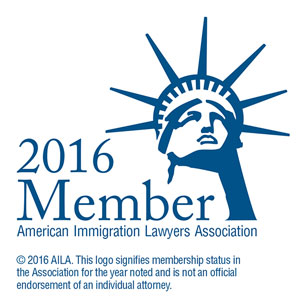By David A. Isaacson
In its recent decision in the case of Khalid v. Holder, the U.S. Court of Appeals for the Fifth Circuit rejected the 2009 decision of the Board of Immigration Appeals (“BIA”) in Matter of Wang. The Fifth Circuit in Khalid held that a derivative beneficiary of an immigrant petition, whose adjusted age even under the Child Status Protection Act (“CSPA”) is above 21, can under section 203(h)(3) of the Immigration and Nationality Act (“INA”) retain the priority date originally given to the principal beneficiary and proceed in the 2B preference category with respect to that principal beneficiary. That is, if your aunt or your grandfather filed a petition for your parent when you were 14 years old, and the petition took one year to process, but a visa number was not available for another 10 years, you can retain the family’s place in the priority-date waiting line as the adult son or daughter of your now-lawful-permanent-resident parent, under the 2B preference, rather than going to the back of the years-long waiting line for an immigrant visa number. The BIA had found in Matter of Wang that such priority date retention was impermissible, but the Fifth Circuit held in Khalid that this ignored the plain meaning of the statute.
In rejecting the BIA’s decision in Matter of Wang, the Fifth Circuit also rejected the decision of the Court of Appeals for the Second Circuit in Li v. Renaud regarding the same CSPA provision, criticized by this author in a previous blog post The Second Circuit had reached essentially the same conclusion as Matter of Wang by finding the CSPA to unambiguously preclude retention of a priority date “to use for a different family petition filed by a different petitioner." The Ninth Circuit in Cuellar de Osorio v. Mayorkas found the statute to be ambiguous and the BIA’s interpretation in Wang a reasonable one, a conclusion also inconsistent with the Fifth Circuit’s decision in Khalid.
The BIA itself had previously taken a more generous view, before changing its mind: Matter of Wang overturned a previous unpublished decision called Matter of Maria T. Garcia, which did allow the aged-out child of a family petition beneficiary to retain the priority date that she previously had shared with her parent. The Fifth Circuit in Khalid found Matter of Garcia to represent the correct approach.
Additional background regarding the CSPA in general and Matter of Wang in particular, for those who are interested, can be found in an earlier article written by this author for our firm’s website. The portion of the CSPA in question, now INA § 203(h), reads as follows:
(h) RULES FOR DETERMINING WHETHER CERTAIN ALIENS ARE CHILDREN-
(1) IN GENERAL.– For purposes of subsections (a)(2)(A) and (d), a determination of whether an alien satisfies the age requirement in the matter preceding subparagraph (A) of section 101(b)(1) shall be made using–
(A) the age of the alien on the date on which an immigrant visa number becomes available for such alien (or, in the case of subsection (d), the date on which an immigrant visa number became available for the alien’s parent), but only if the alien has sought to acquire the status of an alien lawfully admitted for permanent residence within one year of such availability; reduced by
(B) the number of days in the period during which the applicable petition described in paragraph (2) was pending.
(2) PETITIONS DESCRIBED- The petition described in this paragraph is—
(A) with respect to a relationship described in subsection (a)(2)(A), a petition filed under section 204 for classification of an alien child under subsection (a)(2)(A); or
(B) with respect to an alien child who is a derivative beneficiary under subsection (d), a petition filed under section 204 for classification of the alien’s parent under subsection (a), (b), or (c).
(3) RETENTION OF PRIORITY DATE- If the age of an alien is determined under paragraph (1) to be 21 years of age or older for the purposes of subsections (a)(2)(A) and (d), the alien’s petition shall automatically be converted to the appropriate category and the alien shall retain the original priority date issued upon receipt of the original petition.
(4) APPLICATION TO SELF-PETITIONS- Paragraphs (1) through (3) shall apply to self-petitioners and derivatives of self-petitioners.
It is available online as enacted into the U.S. Code at 8 U.S.C. § 1153.
In Matter of Wang, the BIA found that the language of § 203(h)(3) was ambiguous, but that legislative intent showed § 203(h)(3) to codify an existing regulatory practice in which priority dates could be retained when the same petitioner filed a second petition for the same beneficiary. As the BIA explained, this practice was "limited to a lawful permanent resident’s son or daughter who was previously eligible as a derivative beneficiary under a second-preference spousal petition filed by that same lawful permanent resident." Outside that context, the BIA found § 203(h)(3) inapplicable to derivative beneficiaries.
As the Fifth Circuit pointed out in Khalid, however, the BIA’s finding of ambiguity ignores the internal cross-references in § 203(h) and the statute’s clear identification of the petitions to which it applies. Subsection (h)(2), entitled “Petitions described”, makes clear that INA § 203(h) as a whole applies to all derivative beneficiaries, as well as 2A child beneficiaries. Moreover, “(h)(3) expressly references (h)(1), which in turn expressly references (h)(2).” Particularly because subsection (h)(3) expressly applies “for the purposes of subsections (a)(2)(A) and (d)” just as subsections (h)(1) and (h)(2) do, there is no textual basis for excluding from the protection of (h)(3) the derivative beneficiaries under subsection (d) who are all expressly included by (h)(2). Thus, as the Fifth Circuit said in Khalid, “subsection (h)(2) directly answers the question that the BIA found that Congress left unanswered.”
The Second Circuit’s decision in Li is similarly convincingly refuted by the Fifth Circuit in Khalid. Li’s holdingthat a priority date could not be retained “to use for a different family petition filed by a different petitioner” was based on the notion that there is no “appropriate category” to convert to in the sort of scenario at issue in Li and Khalid, because there is, for example, “no family preference category for grandchildren of LPRs”. The Fifth Circuit in Khalid aptly notes that this latter criticism only makes sense if one assumes that a change in petitioners is indeed necessarily impermissible, and that no such rule against a change in petitioners appears anywhere in the text of the statute. Proceeding on this unwritten assumption does leads to the conclusion that, as the BIA held in Matter of Wang, § 203(h)(3) only protects the derivative child beneficiaries of second-preference petitions for a spouse, who were already protected by regulation—but in that case, as the Fifth Circuit noted, “the only difference between the regulation and the Li court’s reading of subsection (h)(3) is that the statute would relieve the spouse of the burden of filing a new petition, since the conversion would now be automatic.” It is, as the Khalid court pointed out, unlikely “that this meager benefit was all Congress meant to accomplish through subsection (h)(3), especially where nothing in the statute singles out derivative beneficiaries of second-preference petitions for special treatment.” Reading the statute as it is written gives much larger and more appropriate significance to § 203(h)(3).
Beyond the legal virtues of the Fifth Circuit’s decision, however, it is worth examining the practical implications of its ruling for those who are not lucky enough to live within the boundaries of the Fifth Circuit, that is, Texas, Louisiana, and Mississippi. As Cyrus Mehta pointed out in a recent blog piece, one way for § 203(h)(3) to benefit many more outside of the Fifth Circuit would be for Attorney General Eric Holder to issue a decision acquiescing in Khalid on a nationwide basis, just as the BIA on the Attorney General’s behalf has acquiesced in favorable Court of Appeals decisions in the past. Unless and until such action is taken, however, one question which arises is whether those who seek the benefit of Khalid may be able to obtain it through litigation even if they reside outside the jurisdiction of the Fifth Circuit.
In cases where the original beneficiary who has now become an LPR seeks to recapture the old priority date under § 203(h)(3) for their derivative son or daughter by filing a new I-130 petition, obtaining the benefit of Khalid may be difficult, at least when the parties do not happen to reside within the Fifth Circuit. Such I-130 petitions will generally be processed either by the California Service Center, which is located within the jurisdiction of the Court of Appeals for the Ninth Circuit (home to Cuellar de Osorio), or the Vermont Service Center, which is located within the jurisdiction of the Court of Appeals for the Second Circuit (home to Li). The initial filing and receipt by USCIS of an I-130 petition will usually take place at the USCIS lockbox in Chicago, within the jurisdiction of the Court of Appeals for the Seventh Circuit, which has not yet ruled on the correctness of Matter of Wang. As an initial matter, therefore, USCIS is likely to follow Matter of Wang in such cases.
If a lawsuit were filed against USCIS to attempt to force compliance with the proper meaning of INA § 203(h)(3) as found in Khalid, the statute governing venue would be 28 U.S.C. § 1391. For actions against U.S. government agencies, 28 U.S.C. § 1391(e) provides:
(e) A civil action in which a defendant is an officer or employee of the United States or any agency thereof acting in his official capacity or under color of legal authority, or an agency of the United States, or the United States, may, except as otherwise provided by law, be brought in any judicial district in which
- (1) a defendant in the action resides,
- (2) a substantial part of the events or omissions giving rise to the claim occurred, or a substantial part of property that is the subject of the action is situated, or
- (3) the plaintiff resides if no real property is involved in the action.
Leaving aside Fifth Circuit residents, therefore, such a lawsuit could only be brought in a district within the Fifth Circuit if that was where “a substantial part of the events or omissions giving rise to the claim occurred”—which is, in the case of an I-130 petition, unlikely for the reasons explained above. For those residing in a circuit other than the Fifth, Ninth, or Second – one which has not yet confronted Matter of Wang – an I-130 filing followed by litigation may still be worthwhile, but would likely have to go up to the relevant Court of Appeals to succeed.
The filing of a new I-130 petition following the adjustment of the original beneficiary, however, is not the only way to seek CSPA protection for a derivative son or daughter under the logic of Khalid. In Matter of Garcia, which the Fifth Circuit in Khalid cited approvingly, the BIA made quite clear that it was the original petition filed for the adjustment applicant’s mother that rendered her eligible for adjustment using the old priority date, after having been automatically converted to a second-preference petition. An additional petition was not necessary; Ms. Garcia was permitted to seek adjustment of status based on the converted old petition. Indeed, the Fifth Circuit in Khalid described the non-necessity of filing a second petition as the one (meager) benefit which 203(h)(3) would provide, at least in 2A derivative cases, even under the Second Circuit’s narrow interpretation. Thus, where visa numbers are available for the appropriate priority date in the 2B preference category, those seeking the benefit of Khalid’s interpretation of the CSPA should be able to simply file a derivative I-485 application for adjustment of status based on the deemed converted petition, and challenging any denial or rejection in federal court, without the intervening step of a new I-130 petition.
Derivative adjustment applications in family-based cases, unfortunately, are filed with the USCIS Chicago lockbox, within the Seventh Circuit where Matter of Wang has not been struck down, and are then generally transferred to the local office in the area where the applicant resides, which for applicants not having the good fortune to reside within the Fifth Circuit will also not be in an area definitively outside the grasp of Matter of Wang. Derivative adjustments in employment-based cases based on a pending or approved I-140 petition, however, are, at least for those living in roughly the eastern half of the U.S., filed with the USCIS lockbox in Dallas or Lewisville in Texas, and generally processed by the Texas Service Center before perhaps being sent to a local office for an interview. Specifically, the area in question includes Alabama, Arkansas, Connecticut, Delaware, District of Columbia, Florida, Georgia, Kentucky, Louisiana, Maine, Maryland, Massachusetts, Mississippi, New Hampshire, New Jersey, New Mexico, New York, North Carolina, Pennsylvania, Puerto Rico, Rhode Island, South Carolina, Oklahoma, Tennessee, Texas, Vermont, Virginia, U.S. Virgin Islands, and West Virginia. For applicants living in those states and territories, if a derivative I-485 based on an I-140 is filed and denied or rejected based on Matter of Wang, it appears that “a substantial part of the events or omissions giving rise to the claim” will have occurred in Texas. (For those applicants in the western and midwestern states not included in the above list, sadly, their I-485 applications will go to the Phoenix Lockbox in the Ninth Circuit and perhaps then the Nebraska Service Center in the Eighth Circuit, which has not yet ruled on Matter of Wang.)
Thus, if the son or daughter of an I-140 beneficiary who would benefit from the Khalid interpretation of the CSPA, residing in one of the listed states within Texas lockbox jurisdiction, files a derivative adjustment application along with their parent’s I-140-based application without awaiting a redundant I-130 by their parent, it would appear that the rejection or denial of that application could be potentially challenged in a Texas federal district court, located within the Fifth Circuit and bound by Khalid. Such a challenge to the legally erroneous denial (or rejection) of an adjustment application by USCIS would be brought under the Administrative Procedure Act, as explained by the Court of Appeals for the Third Circuit in Pinho v. Gonzales, 432 F.3d 193 (3d Cir. 2005). Some other circuit courts of appeals have previously rejected the logic of Pinho, but the Fifth Circuit is not among them; the question of district court jurisdiction over legal error in the denial of an adjustment application, outside the context of removal proceedings, appears to be an open one in the Fifth Circuit.
Due to this jurisdictional uncertainty and the possibility that DHS could avoid the problem by initiating removal proceedings in the beneficiary’s home location, such an approach would be quite risky for any derivative beneficiary residing outside the Fifth Circuit who was not maintaining nonimmigrant status (and was utilizing, for example, INA § 245(i)). However, in those instances where the adult son or daughter of an I-140 beneficiary has acquired a nonimmigrant status of his or her own, and resides in the half of the U.S. that is under the jurisdiction of the Texas lockbox, attempting to file a derivative adjustment application under Khalid without an intervening I-130 petition may be an approach worth considering if visa numbers in the 2B preference category are available for the relevant priority date.




